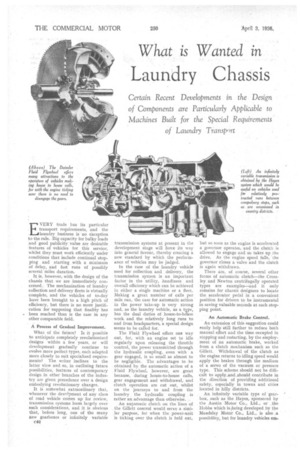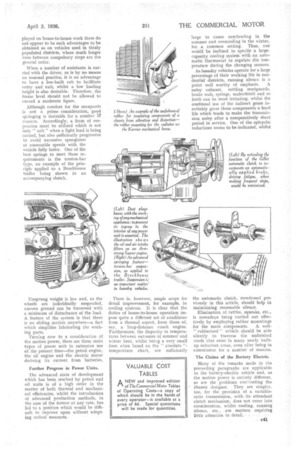What is Wanted in
Page 62

Page 63

If you've noticed an error in this article please click here to report it so we can fix it.
Laundry Chassis
VERY trade has its particular transport requirements, and the laundry business is no exception to the rule. Big capacity for bulky loads and good publicity value are desirable -features of vehicles for this service, whilst they must work efficiently under conditions that include continual stopping . and starting with a minimum of delay, and fast runs of possibly several miles duration.
It is, however, with the design of the chassis that we are immediately concerned. The mechanization of laundry collection and delivery fleets is virtually complete, and the vehicles of to-day have been brought to a high pitch of efficiency, but there is no more justification for supposing that finality has been reached than is the case in any other comparable field.
A Process of Gradual Improvement.
What of the future? Is it possible to anticipate completely revolutionized designs within a few years, or will development gradually continue to evolve more perfect types, each adapted more closely to suit specialized requirements? The writer inclines to the latter view and so, in outlining future possibilities, features of contemporary design in other branches of the industry are given precedence over a design embodying revolutionary changes.
It is somewhat extraordinary that, whenever the devr-Ipment of any class of road vehicle comes up for review, transmission systems loom largely over such considerations, and it is obvious that, before long, one of the many new gearboxes or infinitely variable ralg transmission systems at present in the development stage will force its way into general favour, thereby creating a new standard by which the performance of vehicles may be judged.
In the case of the laundry vehicle used for collection and delivery, the transmission system is an important factor in the utility, handiness and overall efficiency which can be achieved in either a single machine or a fleet. Making a great number of calls per mile run, the case for automatic action in the power take-up is very strong and, as the laundry vehicle, as a txpe, has the dual duties of house-to-house work and the relatively long runs to and from headquarters, a special design seems to be called for.
The Fluid Flywheel offers one way out, for, with an engine set to idle regularly upon releasing the throttle control, the power transmitted through the hydraulic coupling, even with a gear engaged, is so small as almost to be negligible. The advantages to be obtained by the automatic action of a Fluid Flywheel, however, are great because, during house-to-house calls, gear engagement and withdrawal, and clutch operation are cut out, whilst on the journeys to and from the laundry the hydraulic coupling is rather an advantage than otherwise. .
An automatic clutch on the lines of the Gillett control would serve a similar purpose, for when the power-unit is ticking over the clutch is held out, but so soon as the engine is accelerated a governor operates, and the clutch is allowed to engage and so takes up the drive. As the engine speed falls, the governor closes a valve and the clutch is again withdrawn.
There are, of course, several other forms of automatic clutch—the Crossley and Newton centrifugally operated types are examples—and it only remains for chassis designers to locate the accelerator pedal in a convenient position for drivers to be instrumental in saving valuable seconds at each stopping point.
An Automatic Brake Control.
An extension of this suggestion could easily help still further to reduce both manual effort and the time occupied in stopping and restarting, by the employment of an automatic brake, worked from a clutch mechanism such as the Gillett. Withdrawal of the clutch as the engine returns to idling speed would apply the brakes through the medium of a servo of the vacuum or pressure type. This scheme should not be difficult to apply .and should contribute in the direction of providing additional safety, especially in towns and cities located in hilly districts.
An infinitely variable type of gearbox, such as the Hayes, sponsored by the Austin Motor Co., Ltd., or the Hobbs which is!being developed by the Maudslay Motor Co., Ltd., is also a possibility, but for laundry vehicles ems
ployed on house-to-house work there do not appear to be such advantages to be obtained as on vehicles used in thinly populated districts, where much longer runs between compulsory stops are the general order.
When a number of assistants is carried with the driver, as is by no means an unusual practice, it is an advantage to have a low-built cab to facilitate entry and exit, whilst a low loading height is also desirable. Therefore, the frame level should not be allowed to exceed a moderate figure.
Although comfort for the occupants is not a prime consideration, gcme springing is desirable for a number of reasons. Accordingly, a form of suspension must be utilized which is not only " soft" when a light load is being carried, but also sufficiently progressive to avoid excessive sponginess at reasonable speeds with the vehicle fully laden. One of the best springs to meet these requirements is the torsion-bar type, an example of the principle applied to a Brockhouse trailer being shown in an accompanying sketch.
• Unsprung weight is low and, as the wheels are individually suspended, uneven ground can be traversed with a minimum of disturbance of the load. A feature of the system is that there is no sliding motion anywhere—a fact which simplifies lubricating the working parts.
Turning now to a consideration of the motive power, there are three main types of power unit in extensive use at the present time—the petrol engine, the oil engine and the electric motor deriving its current from batteries.
Further Progress in Power Units.
The advanced state of development which has been reached by petrol and oil units is of a high order in the matter of both thermal and mechanical efficiencies, whilst the introduction of advanced production methods, in the case of the former at any rate, has led to a position which would be difficult to improve upon without Adopting radical measures. There is, however, ample scope for detail improvement, for example, in cooling systems. It is clear that the duties of house-to-house operation impose quite a different set of conditions from a thermal aspect, from those of, say, a • long-distance coach engine. Furthermore, the disparity in temperatures between extremes of summer and winter heat, whilst being a very small item when based on the "absolute "temperature chart, are sufficiently • large to cause overheating in the summer and overcooling in the winter, for a common setting. Thus, one would be inclined to specify a largecapacity cooling system with an automatic thermostat to regulate the temperature during the changing seasons.
As laundry vehicles operate for a large percentage of their working life in residential districts, running silence is a point well worthy of emphasis. A noisy exhaust, rattling mudguards, brake rods, springs, undershield and so forth can be most irritating, whilst the continual use of the indirect geats inevitably gives those components a hard life which tends to make the transmission noisy after a comparatively short period in service. One of the epicydic reductions seems to be indicated, whilst
the automatic clutch, mentioned previously in this article, should help in maintaining reasonable silence.
Elimination of rattles, squeaks, etc., is nowadays being carried out effectively by employing rubber mountings for the main components. A well" rubberized " vehicle should be able silently to traverse the unfinished roads that exist in many newly builtup suburban areas, even after being' in commission for a number of seasons.
The Claims of the Battery Electric.
Many of the remarks made in the preceeding paragraphs are applicable to the battery-electric vehicle and, as the motive power is entirely different, so are the problems confronting the Chassis designer. They are simplar, too, for the provision of a variableratio transmission, withits attendant clutch mechanism, does not enter into consideration, whilst cooling, running silence, etc., are matters requiring little attention to detail.












































































































